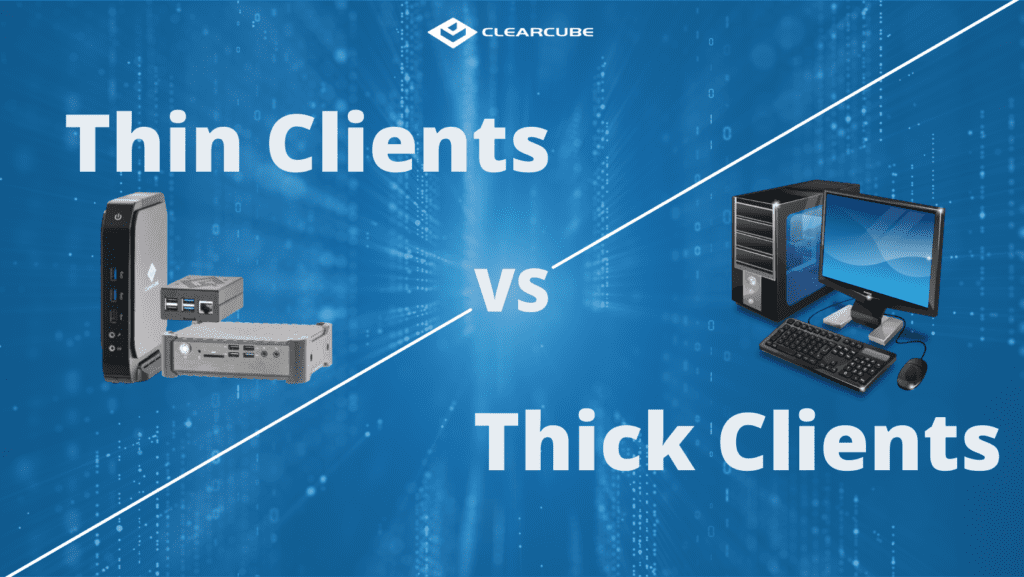
In the realm of computing, understanding the distinction between thin clients and thick clients is paramount for making informed decisions about your technology infrastructure. Thin clients are streamlined devices that primarily function as intermediaries, relying heavily on a central server for processing power and data storage. Conversely, thick clients, often referred to as fat clients, possess more robust local resources, enabling them to execute tasks independently with greater autonomy. This fundamental difference in architecture has profound implications for performance, security, and overall cost considerations.
This article delves into the intricacies of thin client vs. thick client computing, exploring their respective strengths and weaknesses to guide you in selecting the optimal solution for your specific needs. We’ll examine factors such as application requirements, network infrastructure, user preferences, and security protocols to illuminate the path toward making a well-informed decision.
Thin Clients vs. Thick Clients
At their core, thin clients and thick clients represent contrasting paradigms in computing. Thin clients, as their name suggests, are minimalist devices with limited processing capabilities and storage space. They primarily function as terminals, connecting to a central server that handles the heavy lifting of computation and data management. This reliance on a centralized server fosters a streamlined and efficient environment where updates and software deployments are managed centrally, simplifying administration tasks.
Thick clients, on the other hand, are more self-sufficient devices equipped with powerful processors, ample RAM, and substantial local storage. They can execute applications and process data independently, minimizing their dependence on the network for real-time operations. This inherent autonomy empowers thick clients to deliver a richer user experience, particularly for resource-intensive applications that demand immediate responsiveness.
Thin Client Advantages
The minimalist design of thin clients translates into several compelling advantages:
- Cost-Effectiveness: Thin clients typically have a lower upfront cost compared to thick clients, as they require less sophisticated hardware components. This affordability makes them an attractive option for organizations seeking to deploy large numbers of devices without incurring significant capital expenditure.
- Simplified Management: The centralized nature of thin client architecture simplifies IT administration tasks. Software updates, security patches, and configuration changes can be implemented across the entire fleet of devices simultaneously through the central server, reducing administrative overhead and ensuring consistent system configurations.
- Enhanced Security: By concentrating data storage and processing on a secure central server, thin clients minimize the risk of data breaches and malware infections on individual devices. This centralized security model enhances overall network resilience and protects sensitive information from unauthorized access.
Thick Client Advantages
While thin clients excel in certain areas, thick clients offer distinct advantages that cater to specific use cases:
- Offline Functionality: Thick clients can operate independently of the network, enabling users to work offline and continue tasks even when internet connectivity is unavailable. This autonomy is particularly valuable for mobile workers or environments with intermittent network access.
- Resource-Intensive Applications: For applications that demand substantial processing power and memory, such as video editing software or 3D modeling tools, thick clients provide the necessary local resources to deliver a smooth and responsive user experience.
- Customization and Flexibility: Thick clients offer greater flexibility in terms of customization and configuration. Users can tailor their environment to specific needs, installing desired applications and configuring settings according to individual preferences.
Choosing the Right Device
The optimal choice between a thin client and a thick client hinges on a careful evaluation of your specific requirements:
- Application Needs: Consider the nature of the applications you intend to use. If your workload primarily involves web browsing, email, and basic office productivity tasks, a thin client may suffice. However, for resource-intensive applications requiring local processing power, a thick client is more suitable.
- Network Infrastructure: Assess the stability and bandwidth capacity of your network infrastructure. A robust and reliable network is essential for thin clients to function effectively, as they rely heavily on the server for data access and processing.
- User Preferences: Take into account user preferences and comfort levels. Some users may prefer the autonomy and customization options offered by thick clients, while others may find the simplicity and streamlined experience of thin clients more appealing.
Security Considerations
Security is a paramount concern in any computing environment, and both thin clients and thick clients present distinct security considerations:
Thin Clients: The centralized nature of thin client architecture can enhance security by concentrating sensitive data on a secure server. However, vulnerabilities in the central server or network infrastructure can pose a significant risk to the entire system. Implementing robust firewalls, intrusion detection systems, and multi-factor authentication measures is crucial for safeguarding thin client deployments.
Thick Clients: While thick clients offer greater autonomy, they also present a larger attack surface due to their local storage and processing capabilities. Regular software updates, antivirus protection, and user education on security best practices are essential for mitigating risks associated with thick clients.
Conclusion
The decision between thin clients and thick clients is not a one-size-fits-all scenario. Both architectures offer distinct advantages and disadvantages that must be carefully weighed against your specific needs and priorities. By considering factors such as application requirements, network infrastructure, user preferences, and security considerations, you can make an informed choice that aligns with your organization’s goals and objectives.
